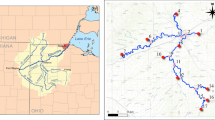Abstract
The representative elementary watershed (REW) approach proposed by Reggiani et al. was the first attempt to develop scale adaptable equations applicable directly at the macro scale. Tian et al. extended the initial definition of REW for simulating the energy related processes, and re-organized the deriving procedure of balance equations so that additional sub-regions and substances could be easily incorporated. The resultant ordinary differential equation set can simulate various hydrological processes in a physically reasonable way. However, constitutive and geometric relationships have not been developed for Tian et al.’s equation set, which are necessary for the thermodynamic watershed hydrological model to apply in hydrological modeling practice. In this work, the constitutive equations for mass exchange terms and momentum exchange terms were developed as well as geometric relationships. The closed ordinary differential equation set with nine equations was finally obtained.
Similar content being viewed by others
References
Yang D W, Xia J. Advances in China PUB: The Complexity of Water Issues and Uncertainty. Beijing: China Water Power Press, 2004
Freeze R A, Harlan R L. Blueprint for a physically-based, digitally-simulated hydrologic response model. J Hydrol, 1969, 9(3): 237–258
Abbott M B, Bathurst J C, Cunge J. An introduction to the European hydrological system—Systeme Hydrologique Europeen, ’sHE’. 1: History and philosophy of a physically-based, distributed modeling system. J Hydrol, 1986, 87(1–2): 45–59
Beven K. Changing ideas in hydrology’the case of physically-based models. J Hydrol, 1989, 105(1–2): 157–172
Beven K. Towards an alternative blueprint for a physically based digitally simulated hydrologic response modeling system. Hydrol Process, 2002, 16(2): 189–206
Beven K. J. A discussion of distributed modeling. In: Refsgaard J C, Kluwer M B A, eds. Distributed Hydrological Modeling, Dordrecht, Netherlands, 1996. 255–278
Refsgaard J C, Storm B, Abbott M B. Comment on “A discussion of distributed hydrological modeling” by Beven K J. In: Refsgaard J C, Kluwer M B A, eds. Distributed Hydrological Modelling, Dordrecht, Netherlands, 1996. 279–287
Tian F Q, Hu H P, Lei Z D, et al. Extension of the representative elementary watershed approach for cold regions via explicit treatment of energy related processes. Hydrol Earth Syst Sci, 2006, 10: 619–644
Duffy C J. A two-state integral-balance model for soil moisture and groundwater dynamics in complex terrain. Water Resour Res, 1996, 32: 2421–2434
Ewen J. “Blueprint” for the UP modeling system for large-scale hydrology. Hydrol Earth Syst Sci, 1997, 1: 55–69
Robinson J S, Sivapalan M. Catchment-scale runoff generation model by aggregation and similarity analyses. Hydrol Process, 1995, 9(5–6): 555
Reggiani P, Sivapalan M, Hassanizadeh S M. Unifying framework for watershed thermodynamics: Balance equations for mass, momentum, energy and entropy, and the second law of thermodynamics. Adv Water Resour, 1998, 22(4): 367–398
Tian F Q. Study on thermodynamic watershed hydrological model (THModel). Ph.D. Thesis. Beijing: Tsinghua University, 2006
Lee H, Zehe E, Sivapalan M. Predictions of rainfall-runoff response and soil moisture dynamics in a micrsoscale catchment using the CREW model. Hydrol Earth Syst Sci, 2007, 11: 819–849
Reggiani P, Hassanizadeh S. M, Sivapalan M. Unifying framework for watershed thermodynamics: constitutive relationships. Adv Water Resour, 1999, 23(1): 15–39
Reggiani P, Rientjes T H M. Flux parameterization in the representative elementary watershed approach: Application to a natural basin. Water Resour Res. 2005, 41(4): 1–18
Lei Z D, Yang S X, Xie S C. Soil Water Dynamics. Beijing: Tsinghua University Press, 1988
Rogers A D. The development of a simple infiltration capacity equation for spatially variable soils. B.E (Honours) Thesis. The University of Western Australia, 1992
Eagleson P S. Climate, soil, and vegetation. III. A simplified model of soil moisture movement in the liquid phase. Water Resour Res, 1978, 14(5): 722–730
Brooks R H, Corey A T. Hydraulic properties of porous media. Colorado State University—Hydrology Papers, 1964, 3: 27
Haverkamp R, Parlange J Y. Predicting the water-retention curve from particle-size distribution: 1. Sandy soils without organic matter. Soil Sci, 1986, 142(6): 325–339
Mualem Y. A new model for predicting the hydraulic conductivity of unsaturated porous media. Water Resour Res, 1976, 12: 513–522
Van Genuchten M Th. Closed-form equation for predicting the hydraulic conductivity of unsaturated soils. Soil Sci Soc Amer J, 1980, 44(5): 892–898
Reggiani P, Sivapalan M, Hassanizadeh S M. Conservation equations governing hillslope responses: Exploring the physical basis of water balance. Water Resour Res, 2000, 36(7): 1845–1863
Zhao R J. The Xin’anjiang model applied in China. J Hydrol, 1992, 135: 371–381
Rui X F. Principles of Hydrology. Beijing: China Water Power Press, 2004. 143–152
Merriam R A. A note on the interception loss equation. J Geophys Res, 1960, 65: 3850–3851
Yi C X. A new formula to calculate the canopy interception. J Soil Erosion Water Conserv, 1996, 2(2): 47–49
Zehe E, Sivapalan M. Towards a new generation of hydrological process models for the meso-scale: An introduction. Hydrol Earth Syst Sci, 2007, 11: 1–7
Author information
Authors and Affiliations
Corresponding author
Additional information
Supported by the National Natural Science Foundation of China (Grant No. 50509013)
Rights and permissions
About this article
Cite this article
Tian, F., Hu, H. & Lei, Z. Thermodynamic watershed hydrological model: Constitutive relationship. Sci. China Ser. E-Technol. Sci. 51, 1353–1369 (2008). https://doi.org/10.1007/s11431-008-0147-0
Received:
Accepted:
Published:
Issue Date:
DOI: https://doi.org/10.1007/s11431-008-0147-0




